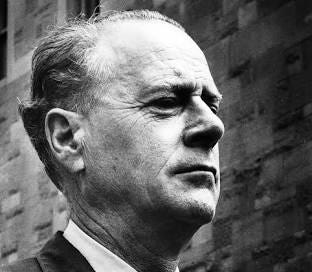I don’t know when I first heard of Marshal McLuhan. It was probably on TVs ‘Laugh-in’. There was a continuing gag where Henry Gibson would appear before the camera for a brief minute and utter, “Marshal McLuhan, what are you doin’.”
It was the kind of joke that separated the men from the boys, intellectually speaking. The boys didn’t give a shit; we men knew better. We knew we didn’t know. Didn’t have the faintest what Marshal McLuhan was doin’. He might tell you, like he did in the Playboy interview, but that doesn’t necessarily mean you’ll understand.
I was a Playboy subscriber in those days, the summer of ‘69. It was two years after the riot and one year after the Tigers won the World Series. I sat on our front steps (Liberal Street on Detroit’s northeast side) and read it over and over again.
I was so into him I wanted to know more, so I went to Wayne State, took a test and they let me in, even with hideous grades in high school. Trouble was, there was no sign of anything like communications courses at Wayne at the time. It never occured to me to simply drive the 300 miles to Toronto and sit at the feet of the man himself.
Instead I bought a paperback copy of Understanding Media and spent hours and hours pondering what it all meant. I got it, in a way, but I’d lose it again on another turn of the page.
In those days me and Gino and Bob, gumbas all, would smoke grass acoss from each other at the kitchen table of their place just off Wayne’s campus. We’d talk about consciouness, and listen to the Beatles ‘White Album’ on a continuous loop. Bob’s view was basically a sexually distorted take on what body postures meant, based on his first year Freud. Gino didn’t have a view, he was a sponge. Consciousness and the abstacting your mind needs to go through to work in that realm were new to him.
I brought McLuhan to the table of consciousness. My best example of McLuhanism was pointing to the lightbulb and asking what it was. Watch their eyes go blank then offer them McLuhan’s rendering, a light bulb is pure information.
The thing that was a light bulb becomes a medium. The light bulb being medium is the message. It is pure information. It is the source of our seeing. We feel it is with us yet it feels like nothing. It is the omniscient information that the light bulb is, that’s the message. The message is not only what we see, but the mode of seeing it, the turning-on light bulb.
Do you see the space you need to recognize that tidbit? It turns out, that place of thinking where the everyday object gets a new assignment is based on communication concepts of Native Americans, probably Algonquins, who were involved in the aboriginal Canadian fur trade when a Canadian professor Harold Innis took an extended canoe trip into the trackless interior to be among the fur traders.
The story told by John Ralston on ‘Marshal McLuhan: What are you doin’?’ is that “Innis came up with his theory of communications out ot his theory of the fur trade which came out of a very extended period of time in which he traveled by canoe through the highways of eternal Canada which is today pre-highway Canada, seeing the fur trade and how it worked. Out of that came the idea of this wholistic, spactial idea of communications which was proper to the aboriginals and not proper to the Europeans.”
This aborginally inspired thinking process effected the other Toronto geniuses of the day, Glenn Gould, Northrup Frye and Marshal McLuhan. As Ralston said, “You really have this very interesting, almost unspoken thing because it didn’t fit into the university way of coming at it. That both Innis and Mcluhan, along with Frye and Gould, were consciously and unconsciously being influenced by the aboriginal philosophy, aboriginal thought.”
As we are told, in the aboriginal world there is no place where spirituality lets off and the material begins. With that in mind, think of a cadre in the clouds of Kondiaronk-like spirits breathing through the aether into the ears of these giants: ‘The medium is the message. The medium is the message.’ Then showing them how.
In Subscribers Reading Room beyond the paywall — Harold Innis on advertising’s ‘ruthless destruction’; McLuhans’s four principles of all media with examples, two.
Keep reading with a 7-day free trial
Subscribe to Acorn Archive to keep reading this post and get 7 days of free access to the full post archives.




